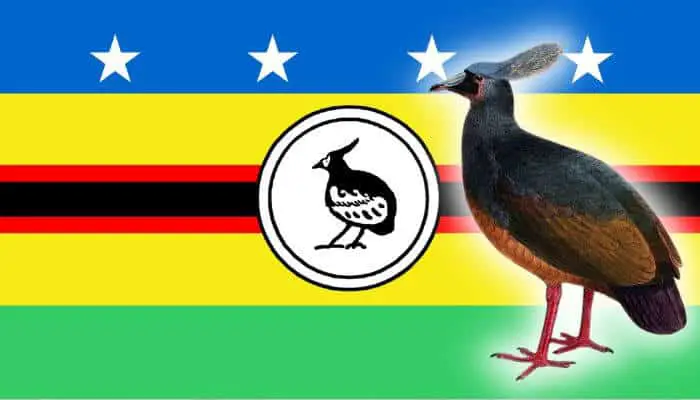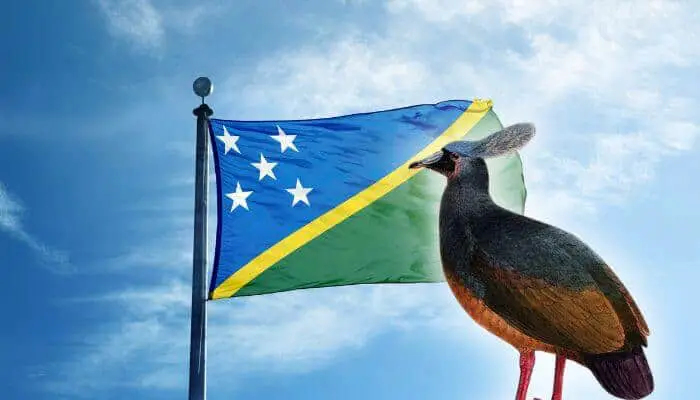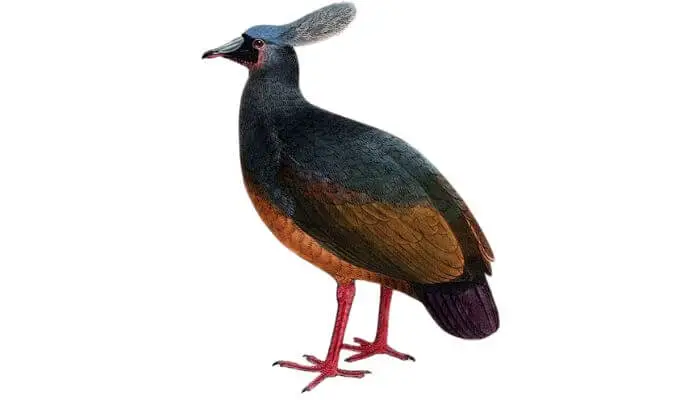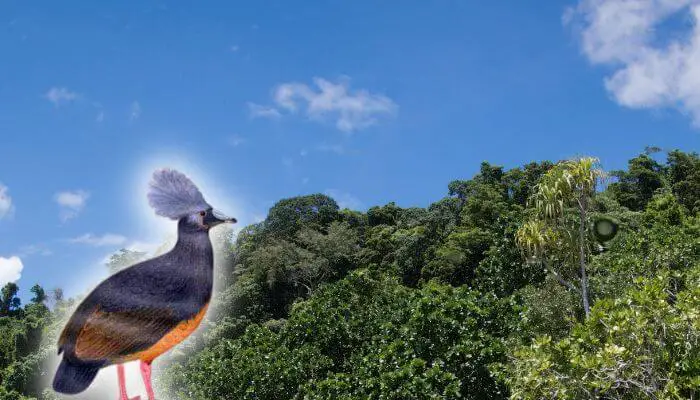Last seen over a century ago, the Choiseul pigeon (Microgoura meeki) was native to Choiseul Island in the southwestern Pacific Ocean.
To date, no other habitats have been documented since the Choiseul pigeon’s extinction.

The Choiseul pigeon became extinct before researchers sufficiently observed and documented its traits. Thus, most of the data we currently have comes from Albert Stewart Meek’s expedition in 1904.
The Choiseul pigeon is also commonly known as Kuvojo, Solomon’s crested pigeon, and Solomon Islands’ crowned pigeon.
Origins of the Choiseul Pigeon
The Choiseul pigeons were monotopic, meaning they were the only representatives of the genus Microgoura.
Researchers haven’t found any subspecies since its discovery.
Following Albert Stewart Meek’s expedition in 1904, Walter Rothschild documented the Choiseul pigeon based on the specimens Meek brought.
The name Microgoura comes from the ancient Greek word mikros, meaning “small.” The other part of the name, “goura,” is a New Guinean native term.
The genus Goura includes crowned pigeons, who have a crest similar to that of the Choiseul pigeon.
Meek was the species name chosen by Rothschild to credit Albert Stewart Meek. Furthermore, Rothschild chose the specific term “meeki” for the Choiseul pigeon.
Distribution & Habitat of the Choiseul Pigeon
Albert Stewart Meek collected the last specimens of the Choiseul pigeon near Choiseul Bay in the northern region of Choiseul Island.
Surrounded by the other Solomon Islands, Choiseul Island lies in the southwestern Pacific Ocean.

To date, Choiseul Island is the only documented habitat of the Choiseul pigeon.
Yet, some researchers uncertainly speculate that the Choiseul pigeon might have inhabited some of the adjacent islands.
Some of the indigenous children have told the researchers that the Choiseul pigeon was in Malaita and Ysabel, two nearby islands.
However, none of those reports were confirmed by researchers.
Unlike many bird species, the Choiseul pigeon didn’t migrate with seasonal changes.
Interestingly, the Choiseul pigeon refuted the treetop lifestyle of most birds. Instead, naturalists believed it preferred the forest floor, especially the swampy coastal sites lacking mangroves.
Closest Columbidae Relatives of the Choiseul
It’s believed that the Choiseul pigeon is most closely related to one living species, the thick-billed ground pigeon (Trugon Terrestris).
The thick-billed ground pigeon commonly inhabits Indonesia and Papua New Guinea.
Additionally, some researchers have suggested that the Choiseul pigeon might have linked the thick-billed ground pigeon with the Groura crowned pigeons.
However, the Choiseul pigeon differs markedly from the Groura crowned pigeons.
Choiseul Pigeon Appearance
| Wingspan | Length | Weight | Coloring | |
|---|---|---|---|---|
| Choiseul Pigeon | 180 – 197 cm | Around 31 cm | Unknown | Bluish grey with some black and orange belly |
| Average Feral Pigeon | 64 – 72 cm | 32 – 37 cm | 300 – 500 g | Bluish grey with some black |
The Choiseul pigeon was a large ground bird. Based on the illustrations by previous researchers, the adult Choiseul pigeon was mostly bluish grey, like many pigeons.
Both the face and forehead were black.

Overall, the Choiseul pigeon’s back was grey-washed, but the lower part shared a similar brownish tint with the tail and wings. The legs were purplish-red.
What sets the Choiseul pigeon apart is its brownish-orange belly and unique crest. The crest and upper head shared the same bluish-grey color.
However, researchers suggest that the crests of the specimens at the museum were laid flat during preservation.
Therefore, we don’t know precisely how this blue crest was positioned on the Choiseul pigeon’s head. Different illustrators have assumed various positions of the blue crest in their drawings.
For instance, John Gerrard Keulemans pictured a flat crest, as shown by Meek’s specimens. Other illustrators have depicted a fanned, scraggy crest similar to the crowned pigeon’s crest.

Another exciting feature on the Choiseul pigeon’s head is the blue shield centered on top of the beak. The surrounding black feathers framed and highlighted the shield and the beak.
Moving on to the body, the Choiseul pigeon’s brown wings were significantly longer than the average length of other pigeon species.
As for the tail, it had a dark purple color complementing the black feathers on the head and body.
Facts About the Choiseul Pigeon
- Hamlin reported that the Choiseul Island’s villagers called the Choiseul Pigeon “kukuru-ni-lova,” which translates to “pigeon-belong-ground.” This name accurately describes the hen-like behavior of the Choiseul Pigeon.
- It was a relatively large pigeon living on the forest’s lowland.
- Besides its beautiful sound, local villagers recalled the gizzard stone, describing it as “gold,” the gizzard stones of the Choiseul pigeons may have had local value which may have contributed to its decline.
- The Choiseul province depicts the Choiseul pigeon on its flag.
- Some ornithologists believe the Choiseul pigeon might be the miniature relative of the world’s largest wild pigeon the Victoria crowned pigeon (Goura victoria).
Choiseul Pigeon Conservation
In 1904, Albert Stewart Meek collected several specimens, including six skins and a unique egg.
The skins are now reserved at New York’s American Museum of Natural History. As for the egg, it’s held at the Natural History Museum at Tring.
Since Meek’s visit in 1904, several expeditions returned to Choiseul Island in search of the Choiseul pigeon but without success.
In 1968, Parker revisited Choiseul Island and questioned the older villagers along the Southcoast area. The villagers who recalled the Choiseul pigeon said they had seen it a long time ago.
According to the villagers, an external mission introduced feral cats to the island to keep the rats under control. On top of that, dogs were trained to help with pig hunts.
Choiseul Island wasn’t inhabited by any carnivorous species before the cats and dogs arrived. Therefore, the Choiseul pigeon had no defense mechanisms against such predators.
Both cats and dogs hunted the Choiseul pigeon and significantly reduced its numbers.
Parker obtained the latest record from local inhabitants who saw a small roost at the time of World War II in the early 1940s.

At that time, Beck and Hamlin from the Whitney Expedition had failed to find the Choiseul pigeon despite receiving help from the native inhabitants.
Parker believes that where feral cats weren’t introduced, the Choiseul pigeon became extinct because of losing its habitat.
For this reason, Parker believed the Choiseul pigeon was absent from Choiseul Bay by the late 1920s. This was caused by removing the original vegetation of Choiseul Bay and replacing it with coconut plantations.
Choiseul Pigeon Character
Some of the villagers’ reports from Hamlin’s 1929 described the exceptional tame behavior of the Choiseul pigeon.
This tame behavior might be the reason behind its extinction since the local boys used to easily catch it in their hands.
Besides, the Choiseul pigeon made little effort to hide its roosting sites. The local boys used to track the roosts on low-branched trees by noting the Choiseul pigeon’s manure on the ground below.
They used to wait until the pigeons fell asleep to seize them effortlessly.
Furthermore, the Choiseul pigeon had a distinctive sound that some locals imitated when shown the illustrations of the bird.
One village chief said that the Choiseul pigeon’s calling sounded like a rising and falling whistle.
He typically heard the Choiseul pigeon’s calling from its nest in the evening.
Mating And Breeding Choiseul Pigeons
None of the researchers who visited Choiseul Island reported that the native people used to breed Choiseul pigeons.
Instead, their roosts were tracked in the lowland forests, and they were hunted as wild birds for feeding.
According to locals, the Choiseul pigeons used to roost in groups of two, three, or four pigeons.
However, the Choiseul pigeon didn’t build nests to lay its eggs. Instead, it used to lay one small, cream-colored egg in unlined hollows in the ground.
